Living in the city? Very enjoyable, because everything is close at hand and easy to get to – plus it never gets boring. One thing’s for sure: the city of the future doesn’t have to be dull and grey or overcrowded. Jan Adriaenssens, director City of Things at imec, believes in a city with lots of greenery and plenty of flexibility. Flexibility in transport and flexibility in the way spaces are used. Smart City technology is the ideal way of adding this flexibility to the city.
Everyone heading for the city
According to the United Nations, almost 70% of the world’s population will live in cities in the future (2050). In Western countries, that will mean having to give up ‘the detached house with a large garden’. This dream is untenable in the long run. We need more woods and green spaces to act as a green lung for our planet, buthis means that not everyone will be able to have their own patch of garden any more. So we will have to get organized and move to cities, close to our jobs, school, leisure facilities and shops. And to create as much space as possible in the city for trees and parks – essential to ensure good air quality and to soak up rainwater – high-rise buildings are often the best solution.
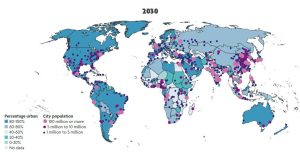
Fig 1: The UN’s prediction of worldwide urbanization and the size of cities by 2030. (Data source: World Urbanization Prospects. The 2018 Revision. Copyright 2018 United Nations, DESA, Population Division. Licensed under creative commons license CCBY3.0IGO)
There are plenty of opportunities for adapting existing cities so that more people can live in them harmoniously, with plenty of greenery in the neighborhood and the ability to move around the city efficiently. Technology will play a major role in making this come true. There have already been several attempts to build ‘the ideal city’ from scratch, although they have not always been successful. Think of Brasilia, for instance, created by the brilliant architect Oscar Niemeyer out of nothing in a matter of years from 1956 on. Every detail was carefully planned out and the latest insights into cities and urban construction applied. And it became a wonderful, yet not very ‘bustling’ city. Since then, Brasilia has found its urban dynamic, but the city’s early years highlighted the dangers of imposing utopian and exaggerated design, as well as organizing everything too rigidly.
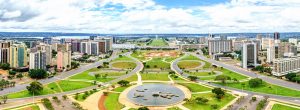
Fig 2: Brasilia, a city built from nothing and designed by clever urban planners, was an illustration of the dangers of allowing utopian design and organization to be too rigid.
Other examples of new cities where no one wants to go and live include the so-called ‘ghost cities’ in China, which were part of a megaplan to relocate 300 million Chinese from the country to the city. These are examples of new cities where literally no one wants to go and live. So it would appear better to allow cities to grow organically – although, of course, that also creates many challenges of its own – and to rethink certain areas in the city and the purposes they are used for.
Mobility apps replacing our cars
One of the big challenges facing cities today is the automobile. Cars take up a huge amount of space: somewhere to park them overnight, somewhere else to park them during the day, main arterial roads and countless traffic lanes. That means a lot (usually too much) of ‘concrete jungle’ that is actually not desirable in a green city. But, by 2035, not all of us will want to have our own car any more. We’ll be using shared means of transport more, like shared(driverless) cars, but also bicycles and delivery tricycles, scooters and so on. Then add buses, metros,light rail and trains to the equation. In one word, our future mobility becomes “CASE”: Connected, Autonomous, Shared, Electric.
This will mean a highly diverse offering of different modes of transport. But within that wide offering also lurks a danger:there will be lots of different providers of shared bikes and cars. Trouble is, with a subscription pass from provider x you won’t be able to hire a bike from provider y. So some form of order will need to be implemented to control that particular ‘chaos’.
“We won’t pay for shared bikes belonging specifically to x any more, but instead we will pay for overall ‘mobility’. We will have service-providers who integrate all of the various shared means of transport into a single system and who will offer us ‘mobility as a service’.”
You enter your current location and required destination into an app and receive proposals of ways to get there. The providers of shared vehicles – including public transport, of course – will open up all of their real-time transport information and ticketing systems for the app. Sure, there will still be various mobility apps, but each one will have its own focus, such as B2B, or focusing on green mobility, etc. In Flanders, you already have integration apps such as Olympus and Whim.
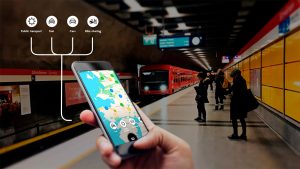
Fig 3: Mobility as a service’ will be the trend of the (near) future. Using a single app, we will be able to organize our whole journey: buy a train ticket, hire a shared electric bike for long distances from the station to the nearby town or city, ride off on a shared scooter in the busy city, etc. One example is the Whim app, which is currently used in Helsinki, Birmingham and Antwerp. [copyright: Whim]
However, the popularity of this diverse offering of transport methods may increase so quickly that it places existing arrangements in the city under too much pressure. For instance, think of the electric bikes and (shared) scooters that are currently all the rage in American and European cities and that cause dangerous situations on the cycle paths which both electric and standard bikes have to use. It’s difficult to fix this because the more static urban planning doesn’t allow to flexibely adjust the allocation of spaces.
But Smart City technology can help here by making the static purpose of certain locations within the city more flexible. This may depend on the weather, time of day, pressure of traffic, etc. For example, the center traffic lane can run one way in the morning and the other way in the evening. Or one traffic lane for cars becomes a cycle path in the morning, close to a school, or a car park becomes a basketball court at the weekend – and so on. And, by gathering data, visualizing traffic flows, centrally controlling digital signboards above the road, automatically installing and removing traffic bollards, etc., the way the city is organized can be made more flexible and efficient. Of course, for this to happen, the various departments within the city will have to work very closely together and aim to achieve a common goal.
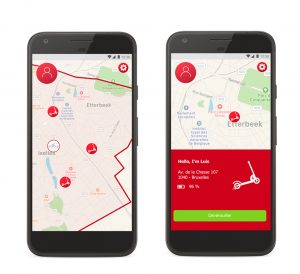
Fig 4: The supply of shared vehicles in the city will increase enormously. An example is the current popularity of shared scooters, like Troty. [copyright Troty]
Every district should have its own letterbox 2.0
These days, it’s not just our own cars that clog city traffic, but also the delivery vehicles needed to bring our online orders to us. Different delivery companies all work independently from each other, yet they sometimes need to deliver packages to the same place. Urban logistics such as this could be a lot more efficient and in the future, more and better integration should certainly be possible. As a result, collaboration between the various providers will be encouraged – and even made compulsory – by the authorities in order to relieve some of the pressure on urban mobility.
Vehicles will not be delivered to each individual home any more, either. Micro-hubs of letterboxes could be set up to service each street or district. These would be two-way letterboxes: so you could put your laundry in the box for one service-provider to pick up, while another supplier deposits your shopping in the same box. Everything is then orchestrated through a single integrated delivery service. You can see this happening already with the Bringme and Cubee boxes that are used flexibly by different users and delivery providers to handle packages.
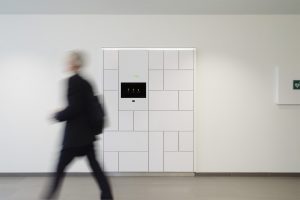
Fig 5: Today, there are already Bringme boxes, which provide a more efficient way of delivering packages. In the future, systems like this will be expanded further for each district to make urban logistics more efficient. (Copyright photo: Bringme)
Here’s the winter collection: now let’s use the 3D printer
Another way of relieving urban logistics is to produce locally. This might mean having greenhouses attached to supermarkets, city garden areas, or vertical farming in which plants grow in artificial light in layers above each other and so on. But other things, such as clothes, can also be produced locally. For instance clothes can be produced to our exact size and needs at 3D printer centers in the city. Not resorting to mass production would be an enormous leap forward for the environment, and – better still – the clothes would fit us better. This would certainly suit people in wheelchairs who need special clothes that take account of the fact that they spend much of the time sitting.
But would this mean saying goodbye to those lovely designer stores in the city? Certainly not! We will still be able to go and admire clothes in their wonderfully tempting displays. But from now on you will be able to have your own ‘Dries Van Noten’ coat – winter collection 2018 nº 5 – made perfectly to your size and in the color you want, produced at the 3D printing center in your local district. We are already seeing this trend for personalization in sports shoes from Nike or with cars. The Flemish software company Twikit specializes in this area. The planet would also benefit more from having local production, because products would no longer need to travel halfway round the world to reach our front door.
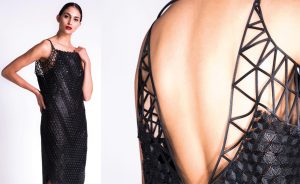
Fig 6: In the future we will produce our clothes with 3D printers, either at home, or at the 3D printer centers in the city. Designers will still create their own collections. It’s just that they will no longer be produced in such large numbers, but to the customer’s size and requirements at 3D printer centers. This dress from fashion designer Danit Peleg comes from a 3D-printed collection. (Photo credits: Daria Ratiner); video: https://www.youtube.com/watch?v=3s94mIhCyt4]
How is imec contributing to this future?
In its City of Things program, imec investigates how technology can improve life in the city. Imec collaborates on this topic with industry, governments, research groups and citizens. For example, imec developes sensor technology as well as data processing and visualization for the city of the future. These sensors measure the quality of the air or river water. They also keep an eye on water levels (project in conjunction with the Antwerp fire department). While the quality and reliability of the sensors are important, so is the way they communicate with each other and the outside world. Which is why imec is also conducting research on IoT networks and 5G. A great deal of research is also being done on real-time open data and shared reference models, so that cities and other players can work together more easily and to make all solutions – existing and new ones – interoperable. For more information about the imec research into the city of the future, visit our website.
Imec is also working on the Smart Flanders program and the Smart Zone program in Antwerp to test technology and algorithms in ‘real life’ situations. Here, once again, feedback from city residents plays an important part in making progress. Each year, imec showcases Smart City trends from the viewpoint of citizens through the Smart City Meter. I mec.livinglabs alsofocuses on involving citizens by co-creating new products and services for the smart city. In 2018, imec and TNO developed a Digital Twin of the city of Antwerp. More info on this Digital Twin can also be found on this webpage.

Jan Adriaenssens is director of City of Things at imec. He is fascinated by the role and impact that technology has in and on society. Jan studied mathematics in Antwerp and philosophy in London. He gained experience with innovation policy as senior researcher at the Flemish Council for Science and Innovation, where he began as a consultant. After this, he went to work as deputy chief-of-staff to the Flemish minister for Innovation. Jan then joined the iMinds research center (which merged with imec in 2016), first as director Strategy & Innovation, and later as vice-president Policy & Society. After imec and iMinds merged, he took on responsibility for imec’s City of Things program, an ambitious living lab and technology laboratory.
This article is part of a special edition of imec magazine. To celebrate imec’s 35th anniversary, we try to envisage how technology will have transformed our society in 2035.











